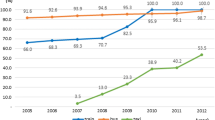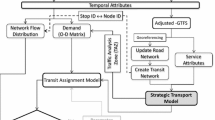Abstract
Public transport origin–destination (OD) estimation based on smartcard data has increasingly been used for transit network planning, passengers’ behaviour analyses and network demand forecasting. While various OD estimation methods using the trip-chaining approach have been developed in recent years, the validity of these estimation methods has not extensively been investigated. This study examines the errors in OD estimation caused by inaccurate inference of alighting stops, to improve the accuracy of the existing trip-chaining algorithms. The distribution of errors is evaluated both at the stop level and the public transport zonal level, given the geographical attributes of each zone and the attributes of the smartcard transactions. While the results show significant associations between zone attributes as well as transaction attributes and the alighting stop inference errors, they undermine the existing algorithm’s assumption that ‘travellers alight a public transport service at a stop which is the closest to their next boarding stop’. Accordingly, this study proposes and evaluates the application of a probabilistic approach using neural networks to infer alighting stops based on a combination of transactional and public transit network attributes. The proposed method is validated using 138,122 smartcard transactions obtained during a normal day in Southeast Queensland, Australia. The results show that our method can improve the accuracy of the existing algorithm by inferring the exact location of 79.5% of the alighting stops and reducing the mean alighting estimation error from 1689 to 503 m for incorrectly estimated alighting stops. At the zonal level, the proposed method also improves the accuracy of the existing algorithm by more than 5%. Finally, the study provides both researchers and practitioners with a method to improve the accuracy of the trip-chaining algorithm and OD estimation, and presents a list of practical guidelines for more effective planning and operation of public transit services.

















Similar content being viewed by others

Notes
These assumptions should continue evolving, considering the emergence and widespread use of new modes of transport, such as (e-)scooters and light (e-)bikes.
References
Alsger A, Mesbah M, Ferreira L, Safi H (2015) Use of smart card fare data to estimate public transport origin-destination matrix. Transp Res Rec J Transp Res Board 2535:88–96
Alsger A, Assemi B, Mesbah M, Ferreira L (2016) Validating and improving public transport origin–destination estimation algorithm using smart card fare data. Transp Res Part C Emerg Technol 68:490–506
Bagchi M, White PR (2005) The potential of public transport smart card data. Transp Policy 12(5):464–474
Barry JJ, Newhouser R, Rahbee A, Sayeda S (2002) Origin and destination estimation in New York city with automated fare system data. Transp Res Rec J Transp Res Board 1817:183–187
Barry J, Freimer R, Slavin H (2009) Use of entry-only automatic fare collection data to estimate linked transit trips in New York City. Transp Res Rec J Transp Res Board 2112:53–61
Chow WSM (2014) Evaluating online surveys for public transit agencies using a prompted recall approach. In: Department of Civil and Environmental Engineering. Massachusetts Institute of Technology
Devillaine F, Munizaga M, Trépanier M (2012) Detection of activities of public transport users by analyzing smart card data. Transp Res Rec J Transp Res Board 2276:48–55
Farzin JM (2008) Constructing an automated bus origin-destination matrix using farecard and global positioning system data in Sao Paulo, Brazil. Transp Res Rec J Transp Res Board 2072:30–37
Gonzalez PA, Weinstein JS, Barbeau SJ, Labrador MA, Winters PL, Georggi NL, Perez R (2010) Automating mode detection for travel behaviour analysis by using global positioning systems-enabled mobile phones and neural networks. Intell Transp Syst 4(1):37–49
Gordon J, Koutsopoulos H, Wilson N, Attanucci J (2013) Automated inference of linked transit journeys in London using fare-transaction and vehicle location data. Transp Res Rec J Transp Res Board 2343:17–24
Hastie T, Tibshirani R, Friedman J (2009) The elements of statistical learning, 2nd edn. Springer, Berlin
He L, Trépanier M (2015) Estimating the destination of unlinked trips in transit smart card fare data. Transp Res Rec J Transp Res Board 2535:97–104
He L, Nassir N, Trepanier M, Hickman M (2015) Validating and calibrating a destination estimation algorithm for public transport smart card fare collection systems. Interuniversity Research Centre on Enterprise Networks, Logistics and Transportation (CIRRELT), Montreal
Jung J, Sohn K (2017) Deep-learning architecture to forecast destinations of bus passengers from entry-only smart-card data. IET Intel Transp Syst 11(6):334–339
Kieu LM, Bhaskar A, Chung E (2015) A modified density-based scanning algorithm with noise for spatial travel pattern analysis from smart card AFC data. Transp Res Part C Emerg Technol 58(Part B):193–207
Kumar P, Khani A, He Q (2018) A robust method for estimating transit passenger trajectories using automated data. Transp Res Part C Emerg Technol 95:731–747
Kusakabe T, Asakura Y (2014) Behavioural data mining of transit smart card data: a data fusion approach. Transp Res Part C Emerg Technol 46:179–191
Langlois GG, Koutsopoulos HN, Zhao J (2016) Inferring patterns in the multi-week activity sequences of public transport users. Transp Res Part C Emerg Technol 64:1–16
Munizaga M, Palma C, Mora P (2010) Public transport OD matrix estimation from smart card payment system data. In: 12th world conference on transport research, Lisbon, Portugal
Munizaga M, Devillaine F, Navarrete C, Silva D (2014) Validating travel behavior estimated from smartcard data. Transp Res Part C Emerg Technol 44:70–79
Nassir N, Khani A, Lee SG, Noh H, Hickman M (2011) Transit stop-level origin-destination estimation through use of transit schedule and automated data collection system. Transp Res Rec J Transp Res Board 2263:140–150
Nunes AA, Dias TG, Cunha JFE (2016) Passenger journey destination estimation from automated fare collection system data using spatial validation. IEEE Trans Intell Transp Syst 17(1):133–142
Pelletier M-P, Trépanier M, Morency C (2011) Smart card data use in public transit: a literature review. Transp Res Part C Emerg Technol 19(4):557–568
R Core Team (2017) R: a language and environment for statistical computing. R Foundation for Statistical Computing, Vienna
Ripley BD, Venables WN (2016) nnet package: feed-forward neural networks and multinomial log-linear models. CRAN
RStudio (2017) RStudio. Boston, MA
Sinnott RW (1984) Virtues of the haversine. Sky Telesc 68(2):159
Venables WN, Ripley BD (2002) Modern applied statistics with S, 4th edn. Springer, New York
Wang W (2010) Bus passenger origin-destination estimation and travel behavior using automated data collection systems in London, UK. In: Department of Civil and Environmental Engineering. Massachusetts Institute of Technology
Acknowledgements
This research was funded by Queensland Department of Transport and Main Roads (TMR), under the TAP agreement with the University of Queensland Centre for Transport Strategy.
Author information
Authors and Affiliations
Corresponding author
Additional information
Publisher's Note
Springer Nature remains neutral with regard to jurisdictional claims in published maps and institutional affiliations.
Rights and permissions
About this article
Cite this article
Assemi, B., Alsger, A., Moghaddam, M. et al. Improving alighting stop inference accuracy in the trip chaining method using neural networks. Public Transp 12, 89–121 (2020). https://doi.org/10.1007/s12469-019-00218-9
Accepted:
Published:
Issue Date:
DOI: https://doi.org/10.1007/s12469-019-00218-9
Keywords
- Origin–destination (OD) estimation
- Alighting stop inference
- Trip-chaining method
- Error distribution
- Neural network
- Deep learning
- Public transport
- Smartcard data



